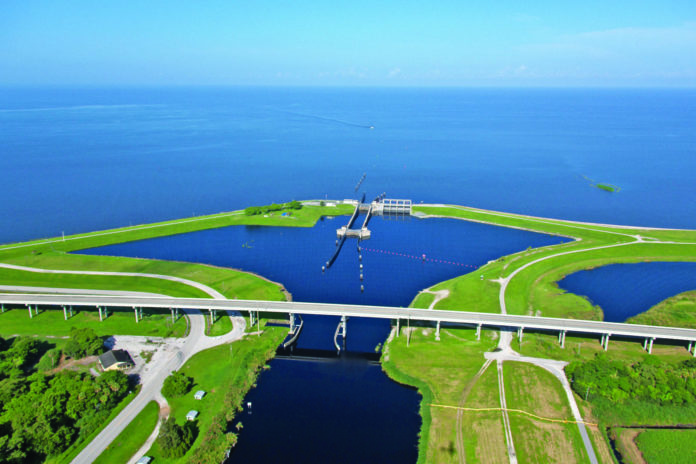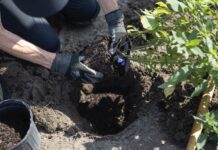
Not many residents understand that the Army Corps of Engineers control the water level in Lake Okeechobee — when to conserve it, when to let it go, and in which direction. Lt. Colonel Jennifer Reynolds, dressed in fatigues, told the audience in Marathon on March 20, the Corps’ first duty was to dispel rumors.
“There is this perception that the Corps is driving the lake level down to 10.5 feet. We have not been told to drive the lake toward any particular level,” she said. “We are looking at everything we can do to mitigate algae blooms in any part of the system.”
The meeting is the beginning of a four-year process to rewrite the manual for the lake’s operation, otherwise known as the Lake Okeechobee System Operating Manual (LOSOM). The last plan was done in 2008. It includes a schedule of public comments, like this meeting, workshops, drafts, and more before the plan is finalized in 2022. Plus, it must incorporate elements of the rehabilitation project for the Herbert Hoover Dike that are not even under construction yet.
The corps added the public comment session to the schedule at the request of U.S. Rep. Debbie Mucarsel-Powell, who made a statement at the meeting.
Tim Gysan with the corps explained the LOSOM update is required by the 2018 Water Resources Development Act.
“And as we complete the C-43 and C-44 we need to understand what will be happening in the next four years,” said Gysan, an engineer with the corps.
The C-43 and C-44 reservoirs are located on either side of Lake Okeechobee and would serve to filter the waters of the re-occurring blue-green algae bloom before they enter Caloosahatchee River to the west of Lake Okeechobee, and the St. Lucie River to the east. To the members of the audience in Marathon, however, was the importance of filtering water south, to drain into Florida Bay.
“We need more fresh water discharge into Florida Bay during rainy season, and a lot more in dry season,” said Ross Boucek, a scientist with Bonefish and Tarpon Trust. “Florida Bay is vulnerable during droughts like the one of 2015. The salinities then were so high, reached salinities that would be recorded in the Great Salt Lake. The seagrass died, rotted and fueled algae blooms.”
Boucek went on to say the trust regularly invests in research. During 2015, the organization was in the middle of sponge research and the species died. “We can’t invest in restoration until these water issues are resolved.”
Other audience members stressed cleaning up the lake waters first, before worrying about releasing the water south to feed Everglades National Park and Florida Bay.
Alina Davis, an Upper Keys resident and Realtor said, “We need to come together to help the lake recover its health. If the water coming downstream is clean, if we can get it downstream, that would help Florida Bay. Until then, we have nothing.”
Not only are the Keys the last literal (geographical) stop for the water draining from Lake Okeechobee, its needs are also far down on the priority scale. One of the corps’ hand outs emphasizes the priorities of “public health and safety and flood control first. Other authorized project purposes evaluated include water supply, runoff, weather, ecological conditions of the lake its surrounding area, navigation, salinity and groundwater control. The last purpose to be listed is “recreation.”
Capt. Fred Ferreira read aloud a letter from a former client canceling a group charter. He said the cost to the guides alone would total about $38,000, more if the lost bookings and reservations for air, hotel and restaurants were counted. Others encouraged the corps to examine safe lake levels that would preserve quality drinking water by excluding saltwater intrusion.
Steve Thomas, an Upper Keys charter captain, questioned the timeline of LOSOM.
“I’m looking at where [the health of Florida Bay] was four years ago, to where we are now … In another four years I’m afraid we’re going to be in big trouble,” he said.
The Herbert Hoover Dike rehabilitation and Everglades Restoration Plans are huge endeavors. In January, Florida Governor Ron DeSantis announced a $625 million plan for Everglades restoration and water resource protection. In February, Gov. DeSantis, and Sens. Marco Rubio and Rick Scott requested President Donald Trump commit $200 million to Everglades Restoration plan. Instead, the federal government committed $68 million was committed. According to the South Florida Water Management District, the state of Florida has outspent the federal government by almost double. From 2000 to 2018, the state and SWFMD have spent $2.34 billion while the feds have contributed $1.3 billion on the Comprehensive Everglades Restoration Plan.

























